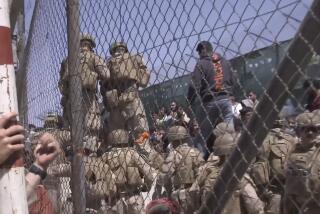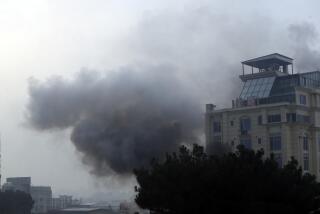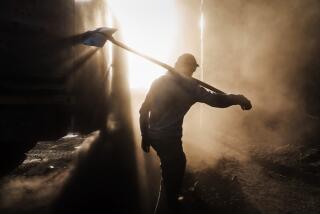Al Qaeda Suspect Is Apprehended
WASHINGTON — Anti-Taliban forces in Afghanistan have apparently captured their biggest known trophy to date, a top Al Qaeda operative who is the son of an extremist Muslim cleric convicted in 1995 of conspiring to blow up New York landmarks, U.S. intelligence officials said Wednesday.
Ahmed Omar Abdel Rahman, 35, was a high-profile figure in Osama bin Laden’s terrorist training camps in Afghanistan, U.S. terrorism officials said. The Pentagon’s Defense Intelligence Agency told the CIA on Wednesday that the Northern Alliance had seized Rahman and was holding him at an undisclosed location. The CIA said it could not independently confirm the report.
Rahman has been an important and popular figure in Al Qaeda, intelligence sources said. He has been widely used in recruiting for the network, they said, because he was believed to be carrying on the work of his father, Omar Abdel Rahman, the so-called Blind Sheik who is being held in one of the highest-security federal prisons in the United States. The father remains an enormously influential figure in the jihad, or holy war, movement even as he languishes behind bars.
There were unconfirmed reports that the younger Rahman and as many as a dozen other captured Al Qaeda operatives would be flown to the Pacific region to be held at a U.S. military facility, perhaps on Guam or Wake Island. This has fueled speculation that such facilities could be the site for military trials of captured terrorism suspects.
A Bush administration official with extensive knowledge of terrorist organizations said: “This is a significant catch. He is a known terrorist, a member of the top Al Qaeda hierarchy.”
The younger Rahman “shows up in [promotional] pictures, and they have been showcasing him, promoting the ties between Al Qaeda and the Blind Sheik,” said Daniel Benjamin, a member of the National Security Council in the Clinton White House and now a terrorism expert at the Center for Strategic and International Studies.
“He is the new model of the jihad and is important symbolically,” Benjamin said. “His connection confers legitimacy on Bin Laden and Al Qaeda.”
Administration officials said the younger Rahman spent many years in Afghanistan in the Al Qaeda training camps, where he played a leadership role among Bin Laden’s inner circle.
Rahman spent several years “trying to cook up ideas on how to get his father released from prison, including kidnapping, but nothing came of it. The Blind Sheik is not going anywhere,” Benjamin said.
Rahman could become an early test of the Bush administration’s plan to prosecute terrorists before a military tribunal rather than in U.S. civilian courts, a proposal that has triggered substantial controversy.
“This is exactly the type of individual that the military tribunal was created for,” the administration official said, describing Rahman as “an out-and-out terrorist who should not be afforded the rights and privileges of an American citizen who should be tried in a civilian court of law.”
As of late Wednesday, however, according to the Defense Intelligence Agency report cited by CIA sources, Rahman remained in custody of the anti-Taliban Northern Alliance, which has been in control of all prisoners taken in the Afghan campaign.
And Robert A. Underwood, Guam’s delegate in Congress, said Wednesday that military and White House officials he had contacted said they had no knowledge of any plans to fly Al Qaeda prisoners to the Pacific region or to try them there.
U.S. officials said the Pentagon has been closely considering the legal implications of potential sites for a tribunal. Deputy Atty. Gen. Michael Chertoff said Wednesday that the makeup of the military tribunals are a work in progress and that some basic elements remain in flux--including whether authorities would require a two-thirds majority for conviction or some “higher level of unanimity,” particularly in death penalty cases.
In congressional testimony, Chertoff noted that military tribunals have been abused by some foreign governments but that the ones being considered by the White House would have checks and balances and might even be held in public to ensure adequate oversight.
Reports of Rahman’s capture, following a recent strike on an alleged Al Qaeda leadership site near the southern Taliban stronghold of Kandahar, emerged on a day in which the Pentagon reported that the U.S. military campaign was raising the pressure on the increasingly isolated Taliban.
But it was also a day in which the first U.S. combat death, that of a CIA undercover operative, was disclosed, and Pentagon leaders warned of a dangerous phase for U.S. and allied soldiers and for civilians.
Pockets of Taliban resistance remain near Kandahar and south of the eastern city of Jalalabad, but “pressure has been stepped up, and there are fewer Taliban and Al Qaeda forces that are resisting than there were days ago,” Rear Adm. John D. Stufflebeem, deputy director of operations for the Joint Chiefs of Staff, said in a Pentagon briefing.
Military strategists have increased the number of warplanes in the skies each day over Afghanistan, from about 90 last week to 120 Tuesday, to strike as soon as Al Qaeda and Taliban sites are spotted. The strikes are focused on emerging targets in the south and on cave and tunnel complexes near Jalalabad.
Amid growing U.S. concern about the dangers posed by roving groups of Taliban fighters in northern Afghanistan, military officials have a ordered small unit of infantry from the 10th Mountain Division into Afghanistan to serve as a protective unit near Mazar-i-Sharif, a defense official said.
The troops, numbering about two dozen, have been reassigned from neighboring Uzbekistan. They will act as a “rapid reaction force” in case of new threats to U.S. personnel but may also take part in other assignments, the official said. The official declined to rule out the possibility that the group’s numbers will increase.
In southern Afghanistan, the number of newly arrived Marines forming a base at an airstrip near Kandahar increased to between 750 and 800, Pentagon spokeswoman Victoria Clarke said.
A video of U.S. F-14 fighters destroying a column of armored vehicles that had approached within miles of the Marines from the west Sunday showed massive secondary explosions that suggested that the Taliban convoy was carrying fuel and explosives, Stufflebeem said.
The U.S.-led campaign has cut off enemy leaders from one another and their troops, Stufflebeem said. On Tuesday, a B-1 bomber destroyed what officials described as a major compound of leaders of Al Qaeda and the Taliban near Kandahar, raining down about 10 bombs.
With much of the leadership “hiding and just trying to survive, the pressure is now being applied to shrink down the areas of where they can go,” Stufflebeem said.
Times staff writers John Hendren and Paul Richter contributed to this report.
More to Read
Sign up for Essential California
The most important California stories and recommendations in your inbox every morning.
You may occasionally receive promotional content from the Los Angeles Times.











